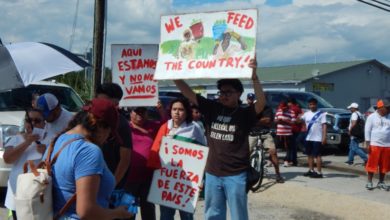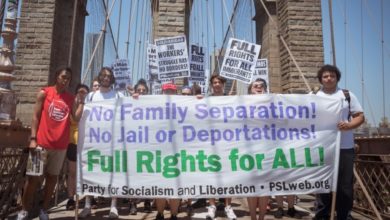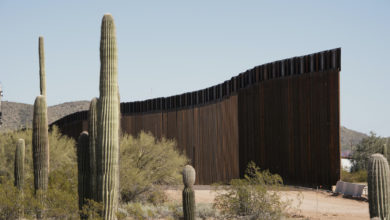Since the last immigration upsurge in 2006, the Obama administration, the Democrats and the Republicans have done everything in their power to ignore the voices of undocumented immigrants, to water down the DREAM Act, to increase the repressive forces at the border, and deport over 1 million immigrants and separate families. Now, after the 2012 election demonstrated the enormous significance of the Latino vote, the political establishment has turned around and promised immigration reform, albeit one tailored to private capitalist interests.
We frequently hear how immigrants are merely “seeking a better life for their children” and trying to fulfill the “American Dream,” but there is no discussion of why the world is such that people cannot sustain their families in their home countries and must migrate to the United States.
Much of the rhetoric around this reform—on both sides of the Congressional debate—accept the terms that undocumented immigrants are criminals. Neither side questions the culpability of U.S. economic and military policies in driving global migration.
A common symbol used in the immigrant rights movement is that of a monarch butterfly. It symbolizes the natural tendency to migrate in certain organisms; they travel long distances in order to adapt to changing environments. However, unlike natural migration patterns developed over thousands of years, modern immigration in the era of advanced capitalism (imperialism) is closer to a forced migration.
Migration is as old as humanity itself, with large-scale migrations typically produced by natural disasters and the physical unsustainability of the existing community. Today, migration is caused less by natural inadequacies and more by countries’ integration into a global economy organized around the profit motive, and the deliberate underdevelopment of certain countries to the benefit of others.
For Latinos living in the United States, their violent displacement is the faded reflection of the violent political and economic intervention waged upon their home country.
Central America: Dictatorships, civil war
While the Cold War era and Reagan’s vicious intervention in Latin America are presented as a distant memory in the narrative of U.S. foreign policy, its effects are still being felt.
In 2011, nearly 3.1 million Central American immigrants resided in the United States, representing close to 8 percent (3.1 million) of the country’s 40.4 million immigrants. This displacement is due almost exclusively to the effects of the civil wars in El Salvador and Nicaragua in the 1980s. El Salvador estimated that more than 25 percent of its population migrated or fled during the country’s civil war, which began in 1979 and ended in 1992.
During the early to mid-1970s, there was a rise of revolutionary forces fighting against U.S.-backed dictatorships in El Salvador and Nicaragua. In 1979 the Frente Sandinista para la Liberación Nacional (FSLN) toppled the Somoza regime and renewed the hopes for revolution in the region. Inspired, the Frente Faribundo Martí para la Liberación Nacional (FMLN) united several political tendencies of the left and sought to bring about the same change in El Salvador.
With the election of Reagan, whose ardent anti-communism, aggressive expansionism and “free market” fundamentalism gave a new wind to the U.S. ruling class, Central America became the battlefront against the tide of revolution. Reagan began funding El Salvador’s right-wing ruling party ARENA (Alianza Republicana Nacionalista) to the tune of $1 million per day, a rate which would last for almost 10 years—in a country the size of Massachusetts. Along with funding, the U.S. trained army death squads which terrorized both countries. Along with the mass killings of its people, Nicaragua suffered through a brutal economic blockade meant to strangle the newly formed Sandinista government. The civil war and forced poverty pushed thousands to flee their homeland.
Mass immigration from Central America, in other words, was not some inevitable economic development. It came from the defeat of socialism as an alternative path of development to overcome the legacies of colonialism and landlordism and reclaim the country’s vast natural wealth. This is the dream of national liberation that inspired and channeled the energy of millions; when this collective dream was defeated by the CIA, the people were forced to turn towards individual and family-based solutions in migration.
Mexico: Neoliberalism and its side effects
Literally in the backyard of the most powerful economic and military power in history, Mexico’s experience with U.S. imperialism includes the direct military invasion and outright robbery of half of its national territory in the mid-1800s. It also includes the North American Free Trade Agreement, through which the Mexican bourgeoisie sought to overcome its own stagnation by offering its national market and cheap labor force to U.S. multinational corporations.
NAFTA produced huge displacement for the working class, peasants and oppressed in Mexico. The trade agreement went into effect January 1994 and made it illegal for Mexico to give preference to national products over U.S. ones and allowed the U.S. to sue the government of “unfair” market practices. It put small Mexican farmers in competition with U.S. agribusiness. It devastated small businesses.
The poverty that NAFTA imposed on Mexico, at a time when the country was going through a population boom, led to the mass exodus of Mexican labor to the United States.
Prior to 1994, it was estimated that around 2 million Mexican immigrants had crossed “illegaly” into the U.S. Almost 20 years later, that number is estimated to be anywhere between 10 to 12 million Mexican immigrants.
The verdict on NAFTA is clear, although the ruling classes of both countries continue to celebrate it. In 2009, it was reported that Mexico became the Latin American country with the highest growth of poverty and inequality in the distribution of wealth.
An extensive report by CONEVAL, a government institution in Mexico that studies the political and social development of the population, stated that between 2006 and 2008 extreme poverty characterized by lack of access to basic nutrition increased from 14.4 million to 19.5 million people.
In 2008, 44.2 percent of the Mexican population was poor. This amounted to over 47.2 million people who did not have access to nutritional and non-nutritional goods that are considered basic. Another 33 percent of the population meet the minimum requirement for basic standard of living but were considered at risk for poverty due to their lack of access to healthcare, education, housing and/or social services.
The conditions nurtured by NAFTA, combined with political turmoil within the Mexican bourgeoisie, have given rise to the violent narco-trafficking often seen on the news. This industry, supplying an enormous market north of the border, has further displaced millions.
In a shocking new report, a consultant from the Association of Local Mexican Authorities of Civil Associations (Aalmac) announced that 150,000 deaths can be attributed to the seven years of the so-called “drug war.” Along with this horrific figure, Juárez Franco stated that 27,523 people are missing, 800,000 women or children have been victims of sexual assault, 50,000 were left without parents and 4.5 million women are without their husbands.
Adding insult to injury, U.S. arms manufacturers and dealers have made fortunes on the drug war across the border, as have major U.S. banks laundering billions of dollars in drug money for the cartels.
Products of a criminal process
While the debate over the pathway to citizenship carries on among ruling class circles in the coming period, it is the role of revolutionaries to explain the real roots of immigration and to expose the capitalists as the real criminals.
Immigrants are the products of an economic system, global capitalism, that has reduced opportunities in their home countries, while opening up considerable paths to migration through Western economic, military and cultural penetration of their homelands. While the bulk of this process is celebrated as globalization—the free flow of capital and goods across borders—the human beings that react to these trends are described as law-breakers.
The PSL fights for a movement where the current victims of imperialism are empowered to fight back, and for a world where workers can freely cross borders, but in which no one must for the sake of survival. That means socialism, which in the United States would entail a vast effort to repair and repay those nations oppressed by imperialism, and would liberate the hoarded social wealth to provide a guaranteed living to all.






